I once posted about the plight of the Pacific Madrone trees on the property. Many of the trees in our woodland areas are weak and diseased as a direct result of decades of poor land and forest management.
This last weekend, while attending our first dairy goat show of the season, one of those diseased Madrones fell, and took out an entire 16 foot doubled run of deer fence, upslope of the garden and orchard.
As it’s peak fawn season, you can imagine what happened once the fence was down, and the farmers were out of town.
This should have been a post about the fun we had at this weekend’s dairy goat show, but show weekend was quickly eclipsed when we returned home and went to check on the gardens after an especially hot weather weekend. I expected I may find a few plants that needed a little extra water. I did not expect to find carnage throughout the summer garden and orchard.
I’ve spent a number of weeks leading up to show season making sure that the summer garden, and orchard, was at a point that it could be left to coast for a while. The warm weather this spring allowed me to get a jump start on transplanting early in the season, and when we hit the road on Friday I felt good about the state of things on the farm. It’s always difficult to be gone, but everything was growing along nicely when we left.
On our return, the first evidence of trouble that I spied was in the cucumber bed.
I intentionally over-planted pickling cucumbers this year, as I have plans for a lot of pickling and canning later in the season. When we left last Friday the vines were robust, and healthy, reaching toward the top of the supports, and producing plenty of blooms, and fruits.
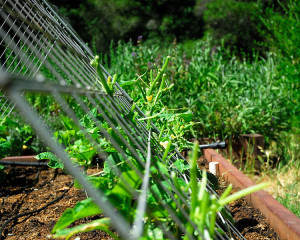
Heirloom ‘Homemade Pickles’ cucumbers, less than half the height they were on Friday. This isn’t rabbits!
At first I thought it was rabbits, but after surveying the rest of the damage, it was clear the deer had gained entry to the garden, and enjoyed the cucumbers immensely.
Then I turned my attention to the pepper beds. The sweet peppers were only slightly gnawed on, with just some of the plants stripped of their leaves.
The hot pepper bed though was decimated. Padróns, Jalapeños, Pepperoncini, and Anchos, were all popular with our garden invaders.
Strangely, the Tomatillos planted in the back of this bed were almost completely untouched.
As I turned the corner though, I was crushed to find that this is all that’s left of the raspberry bed.
There was ripening fruit on Friday, now most of the plants are reduced to mere stubs.
Miraculously the basil was completely untouched. I know that deer tend to avoid some of the garden herbs, like sage, and rosemary, but I would have thought that basil might be more appealing.
At least we have basil. The parsley is gone, but we have basil.
Then I noticed the heirloom tomatoes. Almost every plant had been torn, with branches snapped, or stems abraded where they’d been pulled through the cage supports.
I spent much of yesterday pruning off all of the affected pieces and parts of these plants to reduce the chance of disease in the wounded areas. It’s clear that if the plants had not been caged, the damage would have been MUCH more severe.
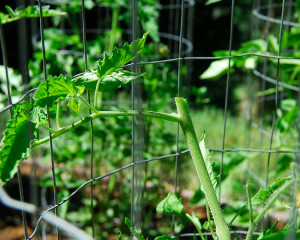
All I could do was remove the torn and ragged stems, which in some cases reduced the plants to half their size
Most of what I had to remove where branch ends that were in full bloom, or had already set fruit. I’m hoping the damage is just a minor set-back, and they’ll recover, but wounded tomato plants can be rendered highly susceptible to disease.
The strawberry bed we renovated this winter also took a hit.
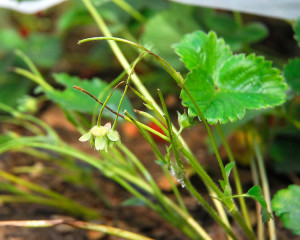
A few plants on the edges of the beds were damaged where the deer pushed underneath the protective netting
Fortunately, the new ProtekNet fine mesh netting we’d put over the beds spared most of the plants, but some around the edges of the bed were sampled.
However, the ‘Consort’ blackcurrants weren’t quite so lucky.
One of the tomato beds this year is right at the crest of the hill above the orchard. As I looked down the hill toward the fruit trees, I almost cried. The lower half of almost every single tree on the south side of the orchard was stripped of its leaves, with broken branches, and obliterated fruit.
Each winter we prune the trees for shape, carefully selecting which buds along a branch we’d like to encourage to grow. The deer clearly disagreed with our choices.

The clean angle-cut was where we pruned this branch in winter to encourage the (now missing) bud to branch out
Last year voles took out two of my favorite rare Niedzwetzkyana crab apple trees. Their replacement has now also been heavily damaged.
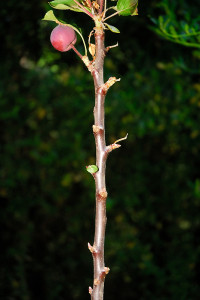
This young Niedzwetzkyana whip has been stripped of most its leaves. Nice of the deer to leave us a token fruit
The trouble with deer damage on some fruit trees, at least in our experience, is that the affected branches have a tendency to die back completely once they’ve been chewed on. As this replacement tree is still a whip, we’ll have to wait and see if it can manage to recover without the central leader dying back.
Esopus Spitzenburg, a relative slow-grower compared to some of our apple trees, also sustained an absurd amount of damage.
Our Aprium, which appeared to be setting its best crop of fruit ever, had its lower branches, and much of its fruit…annihilated.
The Cherry tree was clearly…chomped on.
Plums and pluots were purposefully pruned.
…and the peaches…well, I’m out of alliterations, but let’s face it, around here between the voles, and the deer…our peaches are simply doomed. I honestly sometimes wonder why we bother.
Along the edge of the greenhouse where we’re holding a dozen two year-old 5 gallon grafted apple trees for planting in the fall…every single one was decimated.
It’s been a rough few weeks here on the farm. Between a recent epic feud with a goat-hating neighbor that was caught spraying herbicide across our property, jeopardizing the health of both our goats, and our orchard, bobcats hauling off our poultry stock, and a single 24 hour fence breach resulting in this much damage, I’m finding it extremely difficult not to just throw up my hands and give up.
Fortunately, I’m not a quitter, but I am the type of person that has an innate need to proceed forward toward my goals, and this year I can’t help but feel that all I’m doing is damage control, and not actually making any progress here at all.
I’m exhausted, and right now phenomenally exasperated, and tired of being just one fallen tree, or one persistent predator, away from disaster. My relative lack of garden blogging recently is in part a result of my escalating frustration with the farm this year. The goats are the only thing keeping me even remotely sane at the moment, even though they’ve clearly sparked a war with one irrational neighbor.
Don’t get me wrong, Curbstone Valley is a special place, and I love the woodlands here, the privacy, the wildlife, the creeks, the views, and the rest of my neighbors, but I also am well aware that the farm has the potential to be so much more. Just not here.
For now though, this is where we are, so again, we’ll chalk this up to another experience, that perhaps one day we’ll look back and laugh about. We removed the offending tree, and another that was in similar condition along the fence line yesterday, and repaired the fence. Now we’ll have to wait and see how the damaged plants in the garden and orchard fare through the remainder of this season.
How can deer be so adorable at this time of year, as babies, and mature into the most destructive four-legged garden predators known to man?



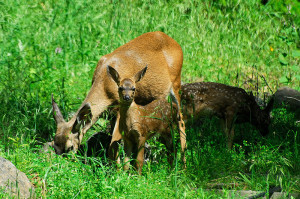
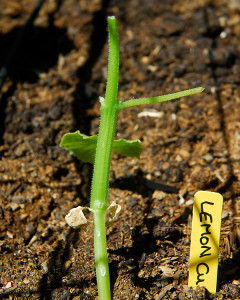
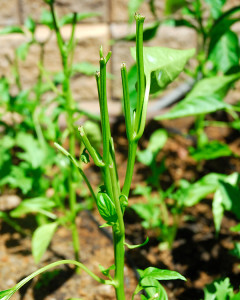

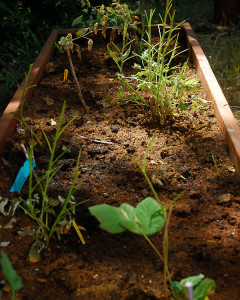
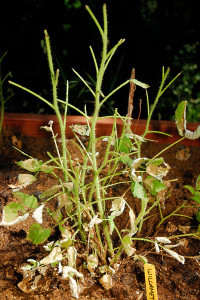


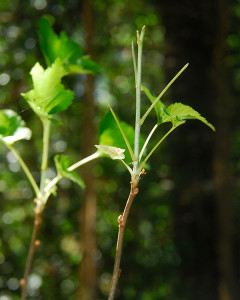
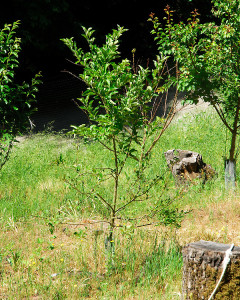

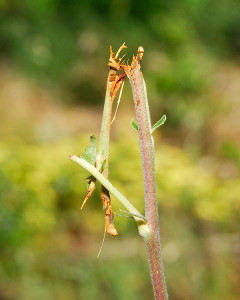
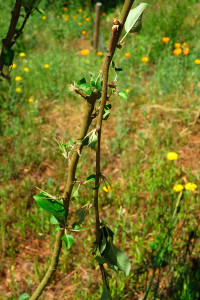
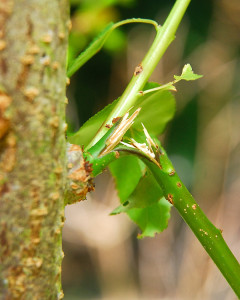

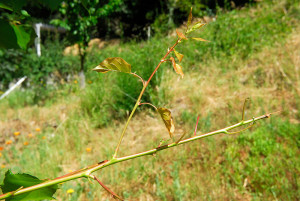
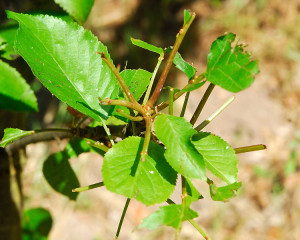
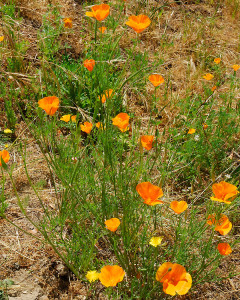
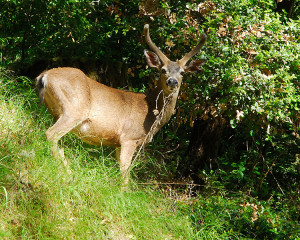
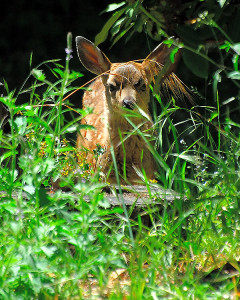







Oh no 🙁 Those deer must have had a ball. Hope your munched-upon plants can recover.
I agree, this was way beyond party…I’m fairly certain there was a rave in our orchard and garden this weekend. Well catered, of course! 😉 I’m hoping as it is early in the season that most of these plants will rebound. At the moment I’m most concerned about the orchard. I swear deer have toxic saliva. We’ve seen trees damaged before where the entire branch that was chewed just turns black, and dies!
How depressing;-( I know it would be expensive, but could you install separate deer fencing around your vege garden and orchard areas? Divide and conquer? A second line of defense?
For the vege garden it is still early in the season so some of your plants may recover. I am so sorry this happened to you.
It’s a good idea. We originally fenced them both together as they’re both in the same area. Facing south to south-west, on the same slope, and fencing a slope this steep is a royal pain. However, you do bring up an interesting point, that if we can fence within that perimeter, when the next tree falls, not if, maybe we can minimize the damage to either the garden OR the orchard, and not both!
Oh, no!! How terrible! I’m sad for you! And a neighbor spitefully spraying herbicide on your property?! Unbelievable. I certainly hope your plants come back bigger and abundantly fruitful for you! (And that your poor little goats stay safe from the chemicals!)
We were livid about the herbicide. As our orchard is maturing, and at the point of producing more fruit (sans fence failures), we were considering applying for certified organic status so we could sell excess fruit at the farmer’s market. The orchard can’t be certified for 3 years though if it is contaminated with herbicide. I don’t understand why this neighbor feels so entitled to use our land, and it’s clear he doesn’t understand the concept of what an easement is!
do you have any legal way to keep your neighbour from damaging your property? I have a horror of neighbours who like clean and tidy ‘accidentally’ spraying our garden. A man once cane to our door and offered to poison our driveway – as a paid service.
Our pair of olive trees at the gate survive and flourish, but my underplanting is attacked as WEEDS by council staff clearing the verge.
I expect, that to have a legal leg to stand on, at least in regards to lost income, we’d need to send this neighbor a formal, legal, written notification that the farm is in organic production. The local certification agency, CCOF (California Certified Organic Farmers) does supply signs that can be posted, but we we’re trying not to make the place look ‘too commercial” out of deference to our neighbors (more fool us). I do think that one, or the other, needs to happen though.
Hang in there. If you were somewhere else, it would be something else.
Have you considered a dog? The right breed of dog might be the solution to keeping the unwanted critters at bay.
We’d love to get a livestock guardian dog, which would also keep the deer further back from the gardens, but for liability reasons we can’t do that here. The area our neighbor sprayed with herbicide is a road easement (just a right to pass) that crosses the entire width of the property. I can’t gate the road as by law we are not permitted to block that easement, and without gates/fences there is risk both to the dog, and potentially to the neighbor that uses the easement to reach his property. We will never own another property with an easement like this. It’s definitely been a lesson learned. It restricts how we can use our land, and when entitled neighbors start doing what they want on the easement, it also jeopardizes our organic production.
ours is a panhandle, so the handle is OURS too. But a little out of sight out of mind to defend.
That’s the challenge. Defending what’s yours. It was clear that the neighbor was shocked we caught him. He even stated “I didn’t know you were in the barn”. Although, honestly, I don’t know what difference that makes. He had no right to be doing what he was doing, regardless!
Oh, no,….Clare, my heart is sinking for you. It’s hard to laugh and think of this from the deer’s point of view right now. I know the loving care you’ve put into everything that was demolished,… And insult to injury, not only having the garden wrecked but the tree and the fence to deal with…I think I’d go take to my bed for an afternoon! But, like you, I’m not a quitter,…to my husbands dismay, I rarely give up.
An experiment? To see how fast the garden recovers? So sorry this happened. I’m sure the deer are napping….with full stomachs.
I’ll definitely be taking note as to how the respective plants recover. Who knows, maybe the cucumbers will be shrubbier if they bounce back, and produce more fruits. My biggest concern is the set backs for the fruit trees. We take our time when shaping the trees during the dormant season, but now so many of the lower branches are damaged. It’s tough, as with the orchard on a slope we prune to keep the tree heights low (to make harvesting easier), but it also leaves them much more vulnerable than a standard height tree when there’s a fence breach 🙁
Oh Clare, what sad news. I felt a little ill as I read your post, I can only imagine how frustrated and upset you must feel. It really brings home the challenges and potential consequences that farmers face, how easily hard work and income can be wiped out. The only positive I can think of is that I’ve eaten some really tasty venison recently, maybe it’s time to even the score a bit?! T x
Our deer pressure here is absurdly high. We tend to see small herds passing through the property. I had one group of 5 bucks wandering around the slopes a couple of weeks ago, and now the does are back, with their fawns in tow. I don’t mind seeing them outside the fence. In the grand scheme of things, it could have been much worse, but it did make me stop and think about all the farmers out there that struggle to produce food. There is always something, no matter where you are. Whether it’s animals eating your crops, pests, disease, drought. I think most of us forget what it takes to produce quality food when, at least in this part of the world, there seems to be an abundance of it. Whatever fails in the garden this summer as a result of this, I will buy from other local farmers though, as I’m happy to support them.
Wow, that’s certainly large-scale destruction! Amazing that it was in just one day — the deer must have been eyeing your enclosure for a while.
The fruit trees are certainly the biggest hit, but for everything else just think of yourself as living in a colder climate, where it’s still early in the season. Your tomatoes are weeks (at least) ahead of mine, but you have the advantage of better-established root systems on everything — I expect you’ll be harvesting tomatoes before I am, regardless of the damage.
Chin up! Gardeners are the penultimate optimists, and I know your little farm (and its farmers) will be fine.
Look on the bright side: it could have been bears attacking your hives, right? 😉
I often had visions of deer in camouflage gear, lurking behind the oak trees on the hill with binoculars and walkie-talkies just waiting for an opportunity. The roots on the Madrone that fell were almost completely gone, probably due to fungal disease that’s common here (that or the deer are in a cahoots with the local gopher population 😉 ). I was stunned at the amount of damage too, and how far they had managed to wander while sampling the all-you-can-eat Curbstone Valley buffet. I guess the deer have good taste! Fortunately though, like you say, we do have a long growing season here, so hopefully all is not lost…I can’t believe I started those tomato plants in January!
Although we don’t have bears, the section of fence that came down was right behind where we keep our hives. I was very grateful that the skunks didn’t get in, as they cause a lot of problems for bees, and do a fair amount of hive damage in their quest to reach honey.
Oh, Clare, I am so sorry to hear about all the heartbreaking damage. Like a tornado.
I’ve heard that donkeys are good, protective watch animals, but I don’t know if they see deer as a threat.
May your garden have a speedy recovery under your careful and loving hand.
Well, keeping it in perspective, it’s definitely not as bad as a tornado, and relatively minor on the scale of natural disasters. It is certainly frustrating, and events like this do take away from other things we need to get done on the farm. By next season though, most of the damage will hopefully be a distant memory. We may have a few funny shaped trees for a few seasons, but it could have been worse.
With our terrain, I used to joke that a guard llama would be perfect here. I’m not sure we have enough flat ground for a donkey. I have always wanted a miniature donkey though, I think they’re adorable! 😛
I feel for your loss. we put a lot of effort into our gardens. Its hard to see it destroyed. for years we never had a garden because the deer would eat everything. I had tulips for years that I never got to see bloom. Until an internet friend told me a local nursery friend told her they hang pouches/sachets of Milorganite around and it kept the deer away. i have been doing for for about 3 yrs now with excellent results. I now grow a complete garden with potatoes, beans, strawberries etc, and nothing is bothered. I see them around the perimeter of my yard and in my neighbors yard, but not in mine. They seem to last about 2 yrs before they need replaced. This yr was about 2 yrs and I started seeing them again in my yard, so I rehung some again, and everything is safe.
It sounds like the Milorganite is working well for you. Unfortunately, for pursuing organic certification, we can’t use products that contain sewage sludge/biosolids on the farm. Although it’s marketed as being an “organic fertilizer”, it is not approved for certified organic production. In fact, it is actually illegal under the National Organic Standards Act to grow certified organic food in sewage sludge.
“The USDA organic seal verifies that irradiation, sewage sludge, synthetic fertilizers, prohibited pesticides, and genetically modified organisms were not used.”
We couldn’t use it, even as a repellent, due to risk of soil contamination…so for now, I’m going to hope our fence holds! 🙂
Oh! Oh! Oh! Glad you haven’t let this sap your spirit or drain your determination or extinguish your enthusiasm! but Oh! And today I was just sitting contemplating our dead madrone and feeling so happy about it – the pygmy nuthatches nested again this year in a knot hole where a branch fell off. I can only hope those darned deer got a sore tummy in punishment for their trespass and spoilage!
Our Madrones here are quite spindly. They’ve spent years scrapping for sun with the Bay Laurels and Douglas Firs, and most of them fall due to some sort of root-rot. I hated cutting down one that was still vertical, but it was paired with the one that fell on the fence, and it seemed imminent that it would follow suit. I wish we had some healthy Madrones on the property. I occasionally see some impressive trees along Hwy 17 that look so much more robust. I just think our woodlands were allowed to get too overcrowded for too long. I’m with you, I hope the deer got a little belly ache as a result of their overindulgence…they deserve it! 😛
Oh, Clare, I am so sorry to hear this. I would be heartbroken. The natural disaster is one thing, but the neighbor? Inexcusable. And the deer? Not liking those little fellows so much anymore… they munched on my Tulips. They say bad things come in 3’s so hopefully your luck will turn. Sending you far away hugs.
Yes, I agree, the neighbor…that was pretty special…and not in good way! Sometimes I really wonder what’s become of the human race. I can’t imagine neighbors being so rude to each other in my grandmother’s day. Our society seems to be becoming increasingly more selfish.
I’m sorry the deer chomped on your tulips. We tried growing tulips the first year, and deer were clearly delighted! Daffodils they ignore, but tulips are like caviar to our local cervid population.
I do hope our run of ‘issues’ in recent weeks is now done. It does seem that things come in waves around here…so I’m hoping the bad is now shaken out of the system for the season, and we can now progress toward something more positive for the rest of the year!
Clare I am so sorry for your losses…deer are such a love/hate relationship as I do know here. And that neighbor is unforgivable….I might have to consider swearing out a complaint for trespassing or destruction of property if that would any good….what is their problem…jerks.
It’s so difficult, in spring, not to ooooh, and ahhh, over the fawns running around the farm. Then it’s equivalently difficult not to #*$&%*#% when they’re all grown up mowing their way from one end of the orchard to the other. I suppose this breach did prove that, providing the fence is intact, it’s working remarkably well at keeping them out. Unfortunately, fallen trees around here are just a fact of life 🙁
As for the neighbor, we did consider sending a formal notification via a lawyer regarding his trespass on the property (even though he has an easement, his actions did constitute trespass as he does not OWN the land). However, he seems like the sort that could/would potentially retaliate, and our greatest concern is for the welfare of our animals (which he clearly despises), so we don’t want to push it this time. He does anything again though, and we’ll prosecute. In the meantime, security cameras will be a must.
My heart breaks. I don’t know how big an area is fenced in, but make sure all the deer are out.
Here’s hoping for a speedy recovery.
That was the first thing I did. There’s a large redwood grove within the fenced in area. It’s a nice shady area, with lots of cover, just perfect for an enterprising deer to hide in. Also, with it being fawn season, we often see does leaving their fawns in areas with good fern or shrub cover, and I didn’t want to accidentally trap a fawn inside the fence area. It looks like we got everyone out though, so hopefully the plants will start to grow back!
Aaargh!! It’s got to be really hard not to despair after losses like this. Reading that your raspberries were decimated made me wonder if I could get my resident deer to eat some of the blackberries that are always threatening to take over the garden. Instead, the perverse deer seem to ignore the brambles and go straight for the garden plants. I hope some of your damaged trees and veg plants recover.
We two types of blackberry that grow wild here, the Himalayan, and a native bramble. The deer seem to love the Himalayan blackberry, but hardly touch the native one. The goats are similarly picky. I’m not sure if it’s the difference in flavor between the two varieties, or the fact our native variety is much MUCH thornier. Clearly though, not all blackberries are equally as appealing.
I am so sorry. I can’t believe the amount of damage. And eating plants isn’t even the worst thing that deer do. Lyme disease is an epidemic in PA. Maybe many of your plants will come back bushier and stronger. I will keep my fingers crossed.
We had a lot fewer ticks in the back garden area last year as our Tom turkey was keeping the deer out of the yard. Not that the ticks don’t hitch a ride on the bobcats, or lizards, but the difference was notable. I’m really hoping the plants come back shrubbier too, we’ll have to see!
I’m so sorry. The deer are understandable. We once owned a house with an easement, and never, ever, ever again. People are harder to deal with than wildlife.
I couldn’t agree more. The deer and bobcats I can deal with, entitled humans are intolerable!
Deer are the worst. For the first time ever I have had them nibbling in the garden but the damage was minimal compared to yours. How many days were you away for them to destroy that much? Was it just one day!?
We were gone less than 48 hours! Nobody heard the tree fall, so I don’t know exactly when it came down, but it was fine when we left. The deer certainly wasted no time helping themselves! 🙁
Oh my gosh, I am so sorry! It hurts just to read about all that damage, I can’t even imagine if I came home to it here (although at the moment my garden is so ridiculously overgrown with lambs quarters and morning glories maybe I’d feel relieved to have deer mow it to the ground). I also hear you on feeling like everything you do is damage control and looking forward to progress. We’re tearing up all the beds and starting over… it’s inspiring but also a little bit awful.